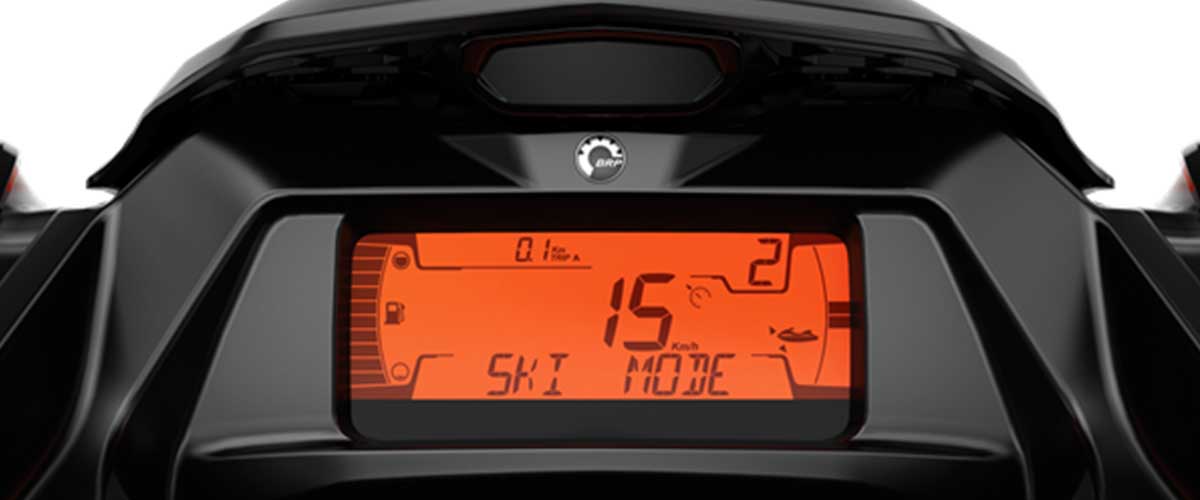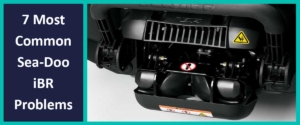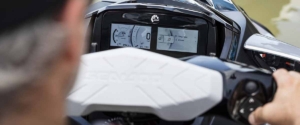Sea-Doo Fault Codes, Beep Codes and Their Fixes [List]
Sea-Doo beep codes are sounds that are never pleasant to hear. Even if you maintain your Sea-Doo carefully, over time problems may occur.
When you hear the beep codes or see the fault messages on your dashboard you most likely start worrying right away.
Is it a serious issue? Can you fix it? How can you diagnose the problem?
The most important thing you can do is calm down, as beep codes and fault messages mean your craft is talking to you. Sometimes it’s just a simple issue, but it must be thoroughly investigated in any case!
If you would like to understand Sea-Doo fault codes, fault messages, and beep codes, this post is for you.
For your convenience, we at JetDrift have compiled all of them into this post. You can also learn what to do if they appear and how to eliminate them!
What Do Sea-Doo Beep Codes Mean?
Sea-Doo beep codes indicate that a minor or major malfunction has been detected by the system. These beep codes often come with fault messages on the dashboard for better understanding. The fault may be coming from the engine, exhaust, fuel line, iBR, or even the electronic system.
As there have been many different Sea-Doo models released over the years, collecting the specific fault codes for each of them would be almost impossible.
Thus, in this post we’ve collected the newest 4-stroke (4-TEC) Sea-Doo fault codes, beep codes and fault messages. As Sea-Doo has used 4-stroke engines with DESS keys for a long time now, your craft is likely powered with this type of power source.
If you have an older model, beware that the vintage 2-stroke Sea-Doo beep codes can be completely different.
That’s why you should refer to your Sea-Doo’s manual every time you notice a beep code or a fault message!
Let’s dig deeper into these codes and learn what to do when they appear.
Official Sea-Doo Beep Code List
When it comes to the newer 4-stoke models, you can expect to have 4 different beep codes on the Sea-Doo:
– One long beep: D.E.S.S. key or ECM issues
– A 2-second beep every 15 minutes interval: Engine management system or iBR faults
– A 2-second beep every 5 minutes interval: Low fuel or fuel sensor issues
– Continuous beeps: Serious engine or exhaust system issues. Turn off the engine immediately!
Let’s take a closer look at each code one-by-one. (Source: Official Sea-Doo Operator’s Guide)
One long beep
(while installing tether cord on watercraft engine cut-off switch)
Bad D.E.S.S. system connection: Reinstall tether cord cap correctly on the engine cut-off
switch.
Wrong D.E.S.S. key: Use a tether cord that has been programmed for the
watercraft.
Defective D.E.S.S. key: Use another tether cord with programmed D.E.S.S. key.
Defective engine cut-off switch: Refer to an authorized Sea-Doo dealer.
Improper operation of ECM or defective wiring harness: Seek service from an authorized Sea-Doo
Dealer or repair shop.
A 2-Second Beep Every 15 Minutes Interval
Watercraft is upside down. Turn watercraft upright!
Engine management system fault: Seek service from an authorized Sea-Doo dealer or repair shop.
iBR system fault: Refer to an authorized Sea-Doo dealer.
A 2-Second Beep Every 5 Minutes Interval
Low fuel level: Refill fuel tank. If problem persists, refer to an authorized Sea-Doo dealer.
Fuel tank level sensor or circuitmalfunction: Refer to an authorized Sea-Doo dealer.
Continuously Beeps
High engine temperature coolant: Chech the „ENGINE OVERHEATING” chapter in the owner’s manual.
High exhaust temperature: Seek service from an authorized Sea-Doo dealer or repair shop.
Low oil pressure: Turn off engine as soon as possible. Check oil level and refill. Seek service from an authorized Sea-Doo dealer or repair shop.
Sea-Doo Fault Message List
Besides the beep codes, the fault messages are just as important.
You can easily read these error messages as they’re clearly displayed where otherwise the special modes like the ’Sport’ or ’Touring’ modes are usually indicated.
What Are Sea-Doo Fault Messages?
Sea-Doo fault messages and indicator lights provide you with information on a special condition that exists on the craft or when any other issues occur. Depending on the problem encountered Sea-Doo fault messages vary widely. The most common messages refer to battery issues, engine or exhaust system problems, or fuel line issues. Sometimes they are simply notifications that warn you to refill the tank or get the regular services done.
Below you can find the official Sea-Doo Fault Message List.
Sea-Doo Fault Message List
| MESSAGE DISPLAY | DESCRIPTION |
|---|---|
| LOW FUEL level indicator, (NO message) | Low fuel level warning |
| LOW or HIGH BATTERY VOLTAGE | Low/high battery voltage |
| HI EXHAUST TEMPERATURE | High exhaust temperature detected |
| HI ENGINE TEMPERATURE | High engine temperature detected |
| LOW OIL PRESSURE | Low oil pressure |
| IBR MODULE ERROR | iBR system fault |
| RIGHT KEYPAD ERROR | Gauge control button malfunction |
| LOW OIL PRESSURE | Engine low oil pressure detected |
| HIGH EXHAUST TEMPERATURE | High exhaust temperature detected |
| CHECK ENGINE | Engine system malfunction or maintenance required |
| HIGH BATTERY VOLTAGE | High battery voltage detected |
| LOWBATTERY VOLTAGE | Low battery voltage detected |
| LIMP HOME MODE | Major fault detected, engine power limited |
| FUEL SENSOR DEFECTIVE | Fuel level sensor fault |
| WATER TEMP SENSOR DEFECTIVE | Problem with water temperature sensor, not sending water temperature info. |
| CALIBRATION CHECKSUM ERROR | Cluster programming corrupted |
| MAINTENANCE REQUIRED | Watercraft maintenance required |
| UNSYNC GPS | GPS signal synchronization with navigation satellites not acquired |
| FUNCTION CANNOT BE ACTIVATED | Message when a function is not or cannot be properly activated |
| O.T.A.S. FAILURE | O.T.A.S. sensor failure (or not detected), or O.T.A.S. system failure |
What to Do if a Beep Code and Fault Message Appear
The first and most important thing to do is stay calm, as in many cases these error messages will cease automatically.
This is because in instances of transient or minor faults, these message automatically disappear if the condition that caused the malfunction doesn’t exist anymore.
Here is What to Do in case of a Sea-Doo Fault Message
- So, if you notice any fault message or beep sound, release the throttle immediately and let the craft return to idle speed. In many cases just doing this can help eliminate the error code and return the craft to normal operation.
- If this doesn’t help, remove the key, wait 3 minutes, and attach the key again.
- Start the engine and check whether the fault message is still active.
- Depending on the type of fault, your Sea-Doo will react differently. In case of a serious malfunction, you probably won’t be able to start the engine.
- What is a Limp Mode on a Sea-Doo? In cases of a minor issue, the system allows you to operate the engine, but with just limited performance. If you can see a „Limp home mode” message on the dashboard, this means you can ride your Sea-Doo but at a reduced speed only, and you must head back to the dock immediately!
- If your Sea-Doo is beeping continuously this refers to a major fault, which means you have to stop the engine immediately. In this case, it’s highly recommended that you not start the engine to avoid further damage. Best practice is to tow your Sea-Doo back to the dock using another vessel.
- Check the owner’s manual for further guidance and get your Sea-Doo inspected by an authorized Sea-Doo dealer as soon as possible.
Sea-Doo Fault Code List
What is a Sea-Doo Fault Code?
The Sea-Doo fault codes (aslo known as Sea-Doo error codes) are an indication that the monitoring system has detected a malfunction. A Sea-Doo fault code consists of an alphanumeric designator and another 3 digits, which are a mix of numbers and letters. The alphanumeric designator identifies the category of the fault, while the next digits define the exact issue.
Beware that unlike fault messages and indicator lights, Sea-Doo fault codes aren’t displayed on the dashboard.
But don’t worry, the system warns you in case of any malfunction with beeps and fault messages, and at the same time, it records a fault code.
Without further ado, the official Sea-Doo fault codes are as follows:
Sea-Doo Manifold Fault Codes
| Code | Malfunction |
|---|---|
| P0106 | Manifold atmospheric pressure sensor out of range |
| P0107 | Manifold atmospheric pressure sensor or |
| P0107 | Manifold barometric pressure sensor shorted to ground |
| P0108 | Manifold atmospheric pressure sensor or |
| P0108 | Manifold barometric pressure sensor shorted to 12V or open circuit |
| P0111 | Intake manifold temp sensor faulty |
| P0112 | Intake manifold shorted to ground |
| P0113 | Intake manifold shorted to 12V or open circuit |
Sea-Doo Engine Sensor Fault Codes
| Code | Malfunction |
|---|---|
| P0116 | Engine temp sensor faulty |
| P0117 | Engine temp sensor shorted to ground |
| P0118 | Engine temp sensor shorted to 12V or open circuit |
Sea-Doo Fuel Line Fault Codes
| Code | Malfunction |
|---|---|
| P01231 | Fuel pump shorted to ground or open circuit |
| P0231 | Burnt starter, fuel pump 10A fuse |
| P0232 | Fuel pump shorted to 12V |
| P0236 | Knock sensor out of range |
| P0261 | #1 injector short to ground or open circuit |
| P0262 | #1 injector shorted to 12V |
| P0264 | #2 injector short to ground or open circuit |
| P0265 | #2 injector shorted to 12V |
| P0267 | #3 injector short to ground or open circuit |
| P0268 | #3 injector shorted to 12V |
| P0461 | Fuel level sensor circuit out of range |
| P0462 | Fuel level sensor shorted to ground |
| P0463 | Fuel level sensor circuit shorted to 12V or open circuit |
Sea-Doo Camshaft and Crankshaft Fault Codes
| Code | Malfunction |
|---|---|
| P0336 | Crank position sensor - wrong RPM detected |
| P0337 | No CPS signal, but CAPS signal detected |
| P0339 | Crank signal fault not plausible with cam signal |
| P0344 | Cam phase sensor signal missing |
| P0344, P1200 | Burnt TOPS 10A fuse |
Sea-Doo Ignition Fault Codes
| Code | Malfunction |
|---|---|
| P0351 | Ignition coil #1 open circuit or shorted to ground or to 12V |
| P0351, P0261 | Burnt cylinder #1 ignition coil and injection 10A fuse |
| P0352 | Ignition coil #2 open circuit or shorted to ground or to 12V |
| P0352, P0264 | Burnt cylinder #2 ignition coil and injection 10A fuse |
| P0353 | Ignition coil #3 open circuit or shorted to ground or to 12V |
| P0353, P0267 | Burnt cylinder #3 ignition coil and injection 10A fuse |
Sea-Doo Exhaust Fault Codes
| Code | Malfunction |
|---|---|
| P0544 | Exhaust gas temperature sensor faulty |
| P0545 | Exhaust gas temperature switch shorted to ground |
| P0546 | Exhaust gas temperature switch shorted to 12V or open circuit |
Sea-Doo VTS Fault Codes
VTS stands for “Variable Trim System,” an acronym Sea-Doo uses for its adjustable trim system.
| Code | Malfunction |
|---|---|
| P1590 | VTS position sensor out of range |
| P1591 | VTS position sensor - low voltage |
| P1592 | VTS position sensor - high voltage |
| P1593 | VTS malfunction |
| P1690 | VTS control up circuit open circuit or shorted to ground |
| P1690, P1692 | Burnt VTS 7.5A fuse |
| P1691 | VTS control up circuit shorted to battery |
| P1692 | VTS control down circuit open circuit or shorted to ground |
| P1693 | VTS control down circuit shorted to battery |
Sea-Doo Electric System/ECU Fault Codes
ECU (Engine Control Unit) is the main computer on 4-stroke Sea-Doos.
| Code | Malfunction |
|---|---|
| P0122 | TPS out of range - short to ground |
| P0123 | TPS out of range - short to 12V or open circuit |
| P0505 | DLA output stage cutoff memory circuit or |
| P0505 | output stage fault or open circuit or short to 12V |
| P0513 | Incorrect DESS key |
| P0520 | Oil pressure switch faulty |
| P0536 | Battery voltage too high |
| P0562 | Battery voltage too low |
| P0600 | CAN communication problem detected by EMS or MPEM |
| P0600 | Burnt MPEM 2A fuse |
| P0601 | TPS learns unlikely or checksum fault |
| P0602 | ECU not coded |
| P0604 | RAM faulty |
| P0605 | EEPROM faulty |
| P0605 | Checksum fault EEPROM |
| P0608 | Sensor 5V power supply short to ground |
| P0608 | Sensor 5V power supply short to 12V |
| P0616 | Starter relay short to ground or open circuit |
| P0616 | Burnt Bilge pump, beeper, diagnostic center 3A fuse |
| P0617 | Starter relay short to 12V |
| P1102 | TPS adaption failure |
| P1104 | TPS adaption cancelled |
| P1148 | Fuel injector 1,2 or 3 - safety fuel cutoff disabled |
| P1200 | Blow-by valve shorted to ground or open circuit |
| P1201 | Blow-by valve shorted to 12V |
| P1202 | Oil tank pressure switch implausible or blow-by valve still closed |
| P1517 | Compass out of range |
| P1607 | MPEM fault |
| P1675 | Spare output 1 shorted to ground or open circuit |
| P1675 | Burnt depth gauge or spare 2A fuse |
| P1676 | Spare output 1 shorted to 12V |
| P1678 | Spare output 2 shorted to ground or open circuit |
| P1678 | Burnt spare 5A fuse |
| P1679 | Spare output 2 shorted to 12V |
| P1680 | Communication problem detected by MPEM |
| P1680, P1681 | Burnt information center 1A fuse |
| P1681 | Communication problem - instrument cluster message missing |
| P1682 | Communication problem - EMS message missing |
| P1683 | COM RAM fault |
How to Read a Sea-Doo Fault Code
You can read the Sea-Doo fault codes with the B.U.D.S (BRP Utility and Diagnostic Software). This means you have to attach a computer to your Sea-Doo on which this software is installed. In the software you can find the Sea-Doo fault codes if you click on the Read Data button and the Faults tab. Aside from B.U.D.S. you can also read a list the fault codes with the easy-to-use CanDooPro Software.
The main advantage of this diagnostic software is that it shows not only the active but also all the previous errors that have occurred in the past. You can browse and list all of your Sea-Doo’s fault codes with their details, along with the required service actions as well.
If you don’t have this software and the diagnostic cables your only way you can read the fault codes is if you take your Sea-Doo to an authorized dealer or service shop.
Conclusion
As you already know there are differences between Sea-Doo fault codes, Sea-Soo check engine codes, fault codes, and beep codes.
Sea-Doo fault messages are displayed on the dashboard and only identify the type of fault. They can inform you whether it’s an engine, electric system, or fuel line malfunction, but unfortunately, they don’t provide exact information about the malfunction.
If a fault message appears on your Sea-Doo’s dashboard, just release the throttle, remove the key, wait 3 minutes, then start the engine again. In many cases, this helps to eliminate the message. If not, always follow the manufacturer’s recommendation.
Sea-Doo beep codes are an extra warning beyond fault messages. If you hear beep codes, always check the dashboard for error messages to get familiar with the malfunction. The most important to do if your Sea-Doo is beeping continuously is to immediately turn off the engine and don’t start it again!
Sea-doo fault codes (or Sea-Doo error codes) are different from fault messages. You can read these fault codes exclusively using special software and diagnostic cables. Your Sea-Doo has to be connected to a computer, and the software can list all of the active and historical fault codes. If you want to read these fault codes, you have to invest in this software with the diagnostic cables. Your other option is to take your Sea-Doo to a dealership or service shop.
If beep codes of fault messages appear on your Sea-Doo, the best practice is for you to check it out in your owner’s manual and follow the manufacturer’s recommendation.
Also, never overlook periodical services like an oil change or winterizing your Sea-Doo, as proper maintenance can reduce the risks of breakdowns and malfunctions!
Sources:
https://www.sea-doo.com/
DISCOVER 2024 PWC MODELS Kawasaki, Sea-Doo, Yamaha, Krash…







